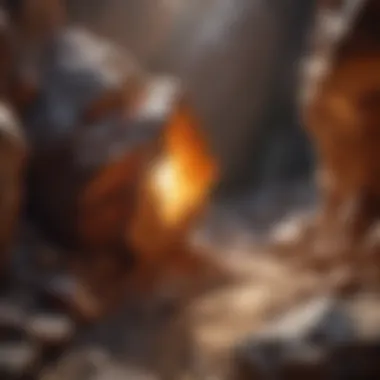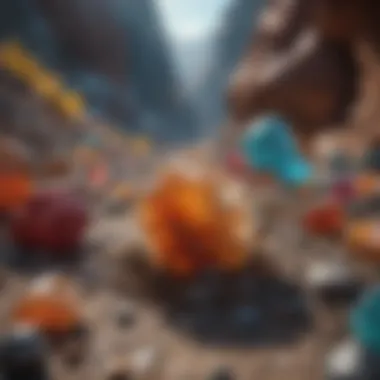Journey Through the Enigmatic World of Minerals, Rocks, and Gemstones


Rock and Fossil Identification
In the realm of minerals, rocks, and gemstones, understanding rock and fossil identification is crucial. Various types of rocks and fossils exist, each with distinctive characteristics that set them apart. When embarking on the journey of identifying these geological specimens, it is essential to look for specific features that denote their unique composition and origin. Utilizing specialized tools designed for rock and fossil identification can greatly aid in the precise categorization of these treasures, allowing collectors to distinguish between different geological wonders.
Collecting Tips and Techniques
For avid rock and fossil collectors, mastering the art of collecting is essential to acquiring prized specimens. Best practices in collecting involve careful observation, meticulous documentation, and ethical sourcing. Locating prime collecting sites requires a deep understanding of geological formations and the habitats conducive to finding rare rocks and fossils. When extracting specimens, it is crucial to follow safety protocols to ensure both the integrity of the specimen and the well-being of the collector. By incorporating proven techniques and strategies, collectors can enrich their collections with valuable and unique geological findings.
Preservation and Display
Preserving rocks and fossils is an art in itself, necessitating the utilization of specialized techniques to maintain the specimens' integrity and longevity. Proper storage methods involve safeguarding specimens from environmental factors that could degrade their quality over time. Creative display ideas play a significant role in showcasing these geological marvels, with collectors often incorporating innovative approaches to showcase the beauty and diversity of their collections. By employing effective preservation methods and thoughtfully planning display arrangements, collectors can ensure that their rocks and fossils remain pristine and visually striking for years to come.
Geological Insights
Beyond the allure of their aesthetics, rocks and fossils offer valuable insights into geological formations, processes, and history. Understanding the geological processes that shape rocks and fossils provides a deeper appreciation for the intricate interplay of forces that have shaped the Earth over millions of years. Rocks and fossils hold historical significance, offering clues to past environments, ancient life forms, and evolutionary trends. Notable discoveries in the field of geology continuously expand our understanding of the Earth's geological past, shedding light on moments of geological significance and unveiling new chapters in our planet's history.
Introduction to Minerals
In this expansive exploration of minerals, their fundamental significance in the world of geology is unraveled with meticulous detail. Understanding the essence of minerals is paramount to comprehending the intricate processes that shape our planet and the treasures it holds. Minerals form the very foundation of the Earth's composition, playing a vital role in various scientific fields and everyday applications. This section delves deep into the complexities of minerals, shedding light on their profound impact on geology, industry, and society.
Definition of Minerals
Exploring the definition of minerals unveils a world of atomic structures and chemical compositions that define the essence of these natural wonders. Delving into the atomic structure of minerals reveals their crystalline nature, emphasizing the arrangement of atoms and molecules that give rise to their unique properties. The intricate dance of atoms within minerals influences their physical and chemical characteristics, making each mineral a distinct entity with specific traits and behaviors.
The chemical composition of minerals encapsulates the elemental makeup that distinguishes one mineral from another. From silicon and oxygen in silicates to carbonate groups in carbonates, the chemistry of minerals dictates their classification and properties. Understanding the chemical composition of minerals is crucial for identifying and categorizing these geological treasures, paving the way for further exploration and analysis.
Classification of Minerals
Within the vast spectrum of minerals, classification plays a pivotal role in organizing these diverse entities based on their structural and compositional characteristics. Silicates, the most abundant mineral group, dominate the Earth's crust with their intricate silicon-oxygen tetrahedral structure. Their prevalence and versatility make silicates a cornerstone of mineral classification, showcasing the diversity and complexity within the mineral kingdom.
Carbonates, bearing the carbonate ion as a defining feature, represent a significant group of minerals with varied properties and formations. From calcite to dolomite, carbonates exhibit a range of colors and textures, offering a mosaic of geological diversity to explore and study. Sulfides, characterized by sulfur combined with a metal or metalloid, present a fascinating array of minerals with distinctive properties influenced by their chemical composition.
Formation of Minerals
The formation of minerals unfolds through a symphony of geological processes that span millions of years, shaping the Earth's crust and mantle. Igneous processes, marked by the cooling and solidification of molten rock, give rise to minerals like quartz and feldspar found in volcanic landscapes. Sedimentary deposition, driven by erosion and sedimentation, lays the groundwork for minerals such as halite and gypsum, formed in ancient seas and lakes.
Metamorphic transformation, spurred by intense heat and pressure, transforms existing minerals into new configurations, yielding gems like jade and garnet with enhanced beauty and durability. Each formation process contributes to the rich tapestry of minerals found in nature, reflecting the dynamic evolution of the Earth's geological history.
Diverse World of Rocks


In the realm of geological specimens, the study of rocks occupies a vital space as they provide insights into Earth's history, processes, and transformations. Understanding the diverse world of rocks is essential for rock and fossil collectors to appreciate the intricacies of the Earth's composition and the unique stories each rock type tells. From igneous formations to sedimentary layers and metamorphic transformations, rocks encapsulate geological events spanning millions of years.
Types of Rocks
Igneous Rocks
Igneous rocks, born from the cooling and solidification of magma or lava, play a fundamental role in Earth's geology. With a characteristic crystalline structure, igneous rocks such as granite and basalt showcase the mineral composition and cooling history of the molten material. Their significance lies in revealing past volcanic activities, geological conditions, and even the Earth's internal processes, making them valuable additions to rock collections.
Sedimentary Rocks
Sedimentary rocks, formed through the deposition and compression of sediments over time, represent a diverse array of rock types like sandstone, shale, and limestone. Their stratified nature provides a visual timeline of environmental changes, climate fluctuations, and even ancient ecosystems. Their importance in this article lies in highlighting the sedimentary processes that preserve fossils, minerals, and significant geological events within their layers.
Metamorphic Rocks
Metamorphic rocks, products of intense heat and pressure acting on existing rocks, offer a glimpse into the transformative powers of Earth's forces. Rocks like marble and quartzite exhibit unique textures, structures, and mineral alignments resulting from their metamorphic history. Their presence in this article sheds light on the geological processes that shape the Earth's crust over time and the intricate changes rocks undergo under extreme conditions.
Rock Cycle
Processes Involved
The rock cycle serves as a dynamic model of Earth's geology, illustrating how rocks transition between igneous, sedimentary, and metamorphic states through a series of processes. From weathering and erosion to burial and metamorphism, the rock cycle embodies the continuous transformation of rocks over geological timescales. Understanding these processes is crucial for collectors to interpret the origins and history of rocks in their collections.
Transformation Over Time
As rocks undergo weathering, erosion, and geological activities, they evolve over time, showcasing alterations in texture, composition, and structure. The concept of transformation over time emphasizes how rocks preserve clues about their journey through different geological environments, geological events, and tectonic movements. This section explores how rocks record Earth's history through their changing forms and characteristics, providing valuable insights for collectors.
Properties of Rocks
Texture
Texture plays a significant role in identifying and categorizing rocks based on their surface features, grain size, and mineral arrangement. Whether coarse-grained, fine-grained, or glassy, textures can reveal information about the rock's formation conditions, cooling rate, and geological processes. Collectors rely on texture to distinguish between rock types, understand their origins, and appreciate the unique visual appeal each texture offers.
Color
The color of a rock, derived from its mineral composition and impurities, contributes to its visual allure and geological significance. From vibrant hues in minerals like azurite to earthy tones in minerals like hematite, colors provide clues about the rock's mineral content, environment of formation, and potential geological alterations. Recognizing the significance of color enhances collectors' ability to identify rocks, discern mineral variations, and appreciate the aesthetic diversity present in geological specimens.
Hardness
Hardness, a measure of a rock's resistance to scratching and abrasion, serves as a fundamental property for assessing the durability and mineral composition of rocks. Rocks with varying hardness levels, from soft gypsum to hard diamond, reflect the presence of different minerals and crystal structures within their composition. Understanding hardness aids collectors in examining rock durability, identifying potential gemstones, and evaluating the geological processes that influenced the rock's formation.


Enchanting Gemstones
Gemstones hold a significant role in the realm of minerals, rocks, and geological specimens. Their allure and beauty have captivated humans for centuries, making them a focal point in this comprehensive guide. By examining the specific elements that define gemstones, we can understand their importance in not just aesthetic but also scientific and economic terms.
Characteristics of Gemstones
Color
Color is a fundamental characteristic of gemstones, playing a crucial role in determining their value and appeal. The depth, intensity, and hue of color in a gemstone can vary immensely, creating a spectrum of choices for collectors and enthusiasts. The color of a gemstone reflects its chemical composition and can range from vibrant to subtle, each conveying a unique personality and charm. Understanding the nuances of color in gemstones is essential for appreciating their rarity and desirability.
Clarity
Clarity refers to the transparency and purity of a gemstone, indicating the presence or absence of inclusions and blemishes. A gemstone with high clarity allows light to pass through unobstructed, enhancing its brilliance and sparkle. The clarity of a gemstone directly impacts its visual appeal and perceived value, making it a key consideration for both collectors and gem enthusiasts.
Cut
The cut of a gemstone refers to its proportions, symmetry, and polish, determining its overall beauty and brilliance. A well-cut gemstone reflects light in a way that maximizes its visual impact, showcasing its color and clarity to full advantage. Different cuts, such as round, oval, or princess, can enhance the inherent properties of a gemstone, making it a popular choice for jewelry designers and collectors seeking to showcase its unique characteristics.
Popular Gemstones
Diamond
Diamonds are renowned for their brilliance, durability, and rarity, making them highly sought after in the world of gemstones. Their exceptional hardness and fire, combined with their timeless elegance, have cemented diamonds as a symbol of luxury and enduring love. The allure of diamonds lies not just in their beauty but also in the craftsmanship required to unlock their full potential, making them a favorite choice for engagement rings and heirloom pieces.
Emerald
Emeralds are prized for their rich green color, symbolizing growth, rebirth, and prosperity. Their vivid hue and distinctive inclusion patterns give each emerald a unique character, making them a favorite among gemstone connoisseurs. The allure of emeralds lies in their rarity and unmistakable beauty, creating a timeless appeal that transcends trends and fashions.
Sapphire
Sapphires are celebrated for their velvety blue hues, embodying wisdom, royalty, and divine blessings. Their intense color saturation and exceptional clarity set sapphires apart as a symbol of purity and sincerity. Sapphires exhibit a range of colors, from cornflower blue to deep teal, captivating collectors with their versatility and individuality.
Gemstone Mining
Extraction Methods
Gemstone mining encompasses a range of techniques used to extract precious stones from the earth, balancing the need for resource extraction with environmental stewardship. Various methods, such as open-pit mining and alluvial mining, are employed to access gemstone deposits while ensuring minimal impact on the surrounding ecosystem. Sustainable mining practices aim to preserve gemstone sources for future generations while upholding ethical standards in excavation and processing.
Impact on Environment


The mining of gemstones can have significant environmental implications, including habitat disruption, water pollution, and deforestation. Addressing the impact of gemstone mining requires sustainable practices that prioritize conservation, land reclamation, and community engagement. By mitigating environmental harm and promoting responsible mining initiatives, stakeholders can ensure the long-term sustainability of gemstone resources while safeguarding the natural ecosystems that support these geological treasures.
Preservation and Collection
In the intriguing world of minerals, rocks, and gemstones, the aspect of preservation and collection holds paramount importance. This section sheds light on the critical need to safeguard and amass these geological treasures for both present and future generations. Preserving these geological specimens ensures their longevity and maintains their scientific and historical significance. Collectors and enthusiasts alike understand the value of preserving these natural wonders as a means of conserving our planet's rich geological heritage.
Preserving Geological Specimens
Storage Techniques
The meticulous preservation of geological specimens relies heavily on effective storage techniques. Proper storage not only safeguards specimens from environmental factors but also aids in organizing and categorizing them for efficient retrieval and study. Utilizing specialized containers, such as archival-quality boxes and cabinets, helps shield specimens from light, humidity, and physical damage, thus ensuring their long-term conservation. The systematic arrangement of specimens based on mineral type, locality, or geological significance enhances their educational and research value.
Cleaning Methods
Cleaning methods play a crucial role in maintaining the pristine condition of geological specimens. By employing gentle cleaning techniques using appropriate tools like soft brushes and mild cleaning solutions, collectors can remove dirt, debris, or mineral residues without causing damage. Regular cleaning not only enhances the appearance of specimens but also prevents contamination and deterioration over time. However, extreme caution must be exercised to avoid altering the natural state or composition of the specimens during the cleaning process.
Tips for Rock and Gemstone Collectors
Rock and gemstone collectors benefit greatly from adhering to essential tips that enhance their collecting endeavors. Researching before collecting and following ethical practices are fundamental to building a well-rounded collection while respecting the environment and legal regulations. By being informed and ethical in their collecting pursuits, enthusiasts contribute to the sustainability of geological resources and promote responsible collection practices.
Research Before Collecting
Thorough research before embarking on a collecting expedition is a prudent step for collectors. Understanding the geological context, mineral characteristics, and legal considerations of target specimens enriches the collecting experience and ensures informed decision-making. By researching the provenance and properties of rocks and gemstones, collectors can add valuable insights to their collections and appreciate the geological significance of each specimen.
Ethical Collection Practices
Ethical collection practices advocate for sustainable and responsible collecting behaviors that prioritize the conservation of natural resources and protection of ecosystems. By adhering to ethical guidelines, collectors help preserve the integrity of geological sites, minimize environmental impact, and support future generations' enjoyment of these treasures. Adopting ethical standards in collection practices underscores a commitment to environmental stewardship and promotes a harmonious relationship between collectors and the natural world.
Display and Exhibition
Curating collections and designing exhibition strategies are essential aspects of showcasing geological specimens to a wider audience. The arrangement and presentation of specimens play a crucial role in highlighting their beauty and educational value. By employing effective curation and exhibition techniques, collectors can share their passion for rocks and gemstones with others while fostering appreciation for the wonders of the Earth.
Curating Collections
Curating collections involves selectively arranging and displaying specimens to tell a cohesive and engaging story. By artfully organizing specimens based on themes, geology, or aesthetics, collectors create visually captivating displays that showcase the diversity and beauty of geological specimens. Curatorial decisions like labeling, grouping, and providing informational plaques enhance the viewer's understanding and connection to the exhibited specimens.
Exhibition Strategies
Developing effective exhibition strategies entails thoughtful planning and presentation techniques that cater to the target audience's interests and educational needs. By selecting compelling specimens, designing interactive displays, and incorporating educational content, collectors can engage visitors and spark curiosity about the world of minerals, rocks, and gemstones. Well-executed exhibition strategies not only entertain and educate but also inspire a deeper appreciation for Earth's geological treasures.
Conclusion
In the realm of mineralogy and geology, the conclusion serves as a pivotal point that encapsulates the essence of our exploration into the fascinating world of minerals, rocks, and gemstones. Throughout this article, we have embarked on a journey through the intricate processes of mineral formation, the classification of rocks, and the allure of gemstones. Understanding and appreciating the significance of these geological treasures not only enriches our knowledge but also deepens our connection to the Earth's history and natural wonders.
Appreciating Earth's Treasures
Appreciating Earth's treasures goes beyond mere admiration; it entails a profound respect for the geological processes that have shaped our planet's wealth of minerals, rocks, and gemstones. As avid rock and fossil collectors, recognizing the value of these specimens extends to preserving their beauty for future generations. This section delves into the aesthetics, composition, and rarity of Earth's treasures, emphasizing the importance of responsible collection practices and ethical considerations in the pursuit of geological wonders.







